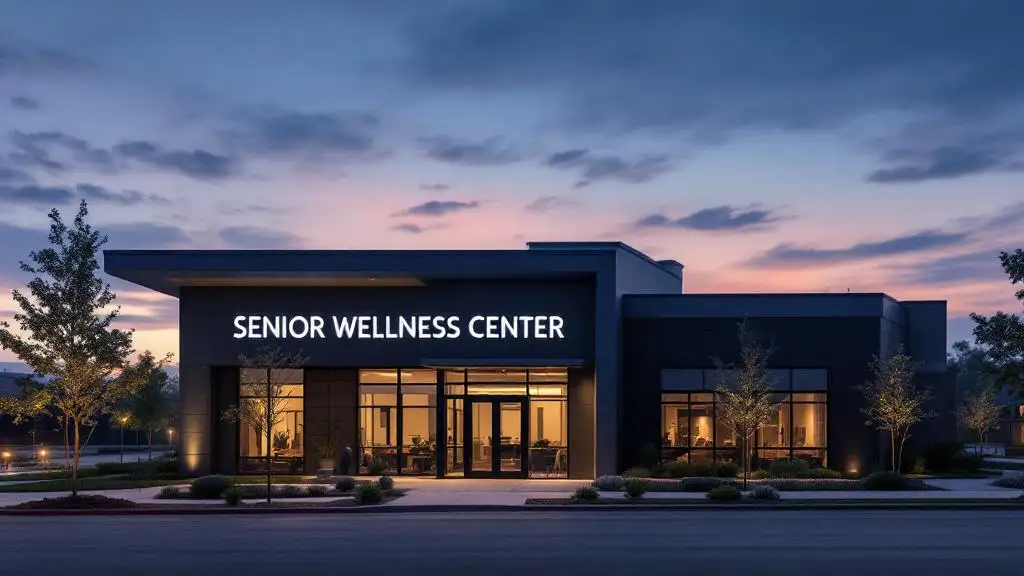The Challenge of Seamless Behavioral Health Referrals
Behavioral health treatment programs, encompassing substance abuse and mental health services, face the complex challenge of offering seamless referral processes within treatment facilities. Inefficient referrals can lead to fragmented care, treatment delays, and patients falling through the cracks. Integrating comprehensive clinical services, enhancing interagency collaboration, and leveraging technology are all crucial to ensuring patients receive timely, coordinated care. This article explores strategies and best practices for creating seamless referral pathways that support holistic, effective treatment and recovery.
Comprehensive Treatment Services: A Multifaceted Approach

What types of services are included in comprehensive treatment programs for substance abuse and mental health issues?
Comprehensive treatment programs for substance abuse and mental health issues encompass a broad spectrum of services designed to address multiple facets of an individual’s condition.
These programs typically begin with medical detoxification, which safely manages withdrawal symptoms. Following detox, patients may receive individual and group therapies such as cognitive-behavioral therapy (CBT), motivational interviewing, and trauma-informed care, aiding in behavioral change and emotional healing.
Medication management is another vital component, involving drugs like buprenorphine, methadone, or naltrexone to treat addiction, alongside medications for co-occurring mental health disorders like depression or PTSD.
Family-based interventions and support groups are integrated into treatment to strengthen the individual's social environment, fostering recovery through improved communication, and addressing systemic impacts of addiction.
A core element is the accurate diagnosis and individualized treatment plans developed through comprehensive assessments, ensuring that overlapping symptoms are correctly identified and that care addresses each patient’s unique needs.
Care coordination and connection to community resources, such as vocational support and housing assistance, complement clinical services to promote long-term recovery and relapse prevention.
In summary, these programs adopt a holistic view by combining medical, psychological, and social interventions to support sustained wellness for those battling substance use and mental health disorders.
The Imperative of Integrating Mental Health with Substance Abuse Treatment

Why is it important to integrate mental health services with substance abuse treatment?
Integrating mental health services with substance abuse treatment is vital because many individuals face co-occurring disorders, such as depression, anxiety, PTSD, or other mental health conditions alongside their addiction. When these conditions are treated separately or one is overlooked, recovery efforts can be compromised, and risks of relapse increase.
Benefits of integrated treatment models
Integrated treatment creates a holistic approach by addressing both substance use and mental health simultaneously. This approach helps build emotional resilience and coping strategies while managing cravings and mood disturbances effectively. It fosters self-awareness and motivation, enhances communication skills, and improves relationships, which are crucial for sustained recovery.
Outcomes of addressing mental health alongside addiction
Evidence indicates that integrated care results in better clinical outcomes: patients experience reduced substance use, fewer hospitalizations, and longer periods of sobriety. Addressing mental health alongside addiction ensures that clients receive comprehensive support tailored to their complex needs.
Effects on relapse prevention and patient motivation
Mental health support decreases feelings of isolation and enhances motivation, which are essential in preventing relapse. Through multidisciplinary teams using validated screening tools, treatment can identify at-risk individuals and connect them promptly to appropriate care pathways. This comprehensive approach supports continuous engagement and strengthens the patient’s capacity to maintain long-term recovery.
Addressing a Spectrum of Addictions Beyond Substance Abuse

How do treatment programs address various forms of addiction besides substance abuse?
Treatment programs increasingly recognize that addictions extend beyond substance abuse to include behavioral addictions such as gambling, internet use, and compulsive shopping. These programs adopt a comprehensive approach that targets common neurobiological and psychological mechanisms underlying different addiction types. For instance, impulsivity, reward pathways, and emotional dysregulation are shared elements across both substance and behavioral addictions.
Evidence-based psychosocial interventions form the backbone of treatment. Therapies like cognitive-behavioral therapy (CBT), motivational enhancement therapy (MET), and acceptance and commitment therapy (ACT) are applied across diverse addictions, helping individuals understand their behaviors and develop healthier coping skills. Mindfulness-based strategies further support self-regulation and relapse prevention.
Pharmacological treatments also play a role, especially medications such as naltrexone that reduce cravings and alter neurochemical pathways common to several addictions. These medications complement psychosocial therapies to enhance outcomes.
Tailoring interventions to the specific addiction is key. Understanding the unique social and psychological contexts of each addiction type enables programs to personalize care while maintaining a holistic outlook. This includes addressing co-occurring mental health conditions and respecting cultural backgrounds.
Through this integrated and flexible approach, treatment programs aim to help individuals acknowledge their addiction, engage in meaningful change, and sustain long-term recovery across the wide spectrum of addictive behaviors.
The Crucial Role of Interagency Collaboration for Holistic Care

Why is collaboration among behavioral health providers essential?
Effective collaboration among agencies serving individuals with substance abuse disorders is vital to delivering comprehensive care. Without coordinated efforts, patients risk receiving fragmented services that overlook crucial aspects of their health and social needs.
How does collaboration prevent fragmented services?
Agencies working together can pool their resources and expertise, ensuring that clients receive well-rounded support rather than isolated interventions. This integrated approach helps prevent clients from 'falling through the cracks' by addressing unfulfilled needs across multiple sectors such as mental health, housing, and employment.
What benefits arise from shared assessments and information exchange?
Shared assessments enable providers to view clients from a holistic perspective, improving referral accuracy and treatment planning. Interconnected networks that allow equal partnership between agencies foster transparency and continuous communication, reducing duplication and ensuring that every service contributes to seamless care.
How do trust and credibility among providers enhance collaboration?
Mutual credibility and trust form the foundation for effective interagency collaboration. When agencies trust each other's capabilities and information, they are more likely to share data openly and engage in joint decision-making. This environment supports integrated service delivery, leading to better health outcomes for individuals facing substance abuse challenges.
Barriers to Effective Collaboration and Referral Networks
What Are the Challenges Created by Competition and Funding Issues Among Agencies?
Competition between agencies and funding structures can hinder collaboration by encouraging agencies to operate in silos. When funding rewards only one agency's achievements, it discourages sharing credit or resources, which compromises a united approach to client care.
How Do Confidentiality Constraints Affect Collaboration?
Strict confidentiality regulations limit the flow of information necessary for seamless referrals. Without sharing critical client data, agencies struggle to coordinate services effectively, increasing the risk of patients "falling through the cracks".
What Role Do Credential Disparities Among Staff Play?
Differences in staff qualifications and training across agencies create barriers to collaboration. Varied credentialing standards can complicate trust and shared understanding among professional teams, impeding integrated care delivery.
How Do These Barriers Impact Continuity and Seamless Care?
Fragmented communication, competition, and credential gaps result in disjointed referrals and treatment plans. This fragmentation interrupts service continuity, delays patient access to care, and diminishes overall treatment effectiveness.
To overcome these challenges, designating a primary agency to conduct comprehensive assessments and serve as the main contact can ensure smoother transitions and continuous support across service sectors. Building mutual trust, establishing shared information systems, and aligning funding incentives are also essential for fostering integrated, client-centered referral networks.
Designating Primary Contact Agencies to Reduce Fragmentation

Assigning One Agency for Comprehensive Assessment
Designating a single agency as the primary contact for clients undergoing substance abuse treatment helps centralize comprehensive assessments. This agency conducts thorough evaluations that consider the client's holistic needs, including mental health, social supports, and other co-occurring conditions. By serving as the main point of contact, this agency can coordinate referrals and services efficiently across the continuum of care.
Ensuring Continuity Across Multiple Service Sectors
When one agency leads the assessment and referral process, it reduces fragmentation by bridging communication gaps between mental health providers, medical facilities, social service organizations, and substance abuse treatment centers. This continuous oversight ensures that client information flows seamlessly, minimizing redundant evaluations and preventing patients from falling through service gaps.
Benefits for Patient Experience and Treatment Adherence
Centralizing contact improves the patient's experience by simplifying appointment scheduling and eliminating confusion caused by multiple points of contact. It fosters trust and rapport by providing consistent support throughout treatment journeys. Patients benefit from coordinated care, resulting in higher treatment adherence, fewer missed appointments, and reduced delays. Overall, this model supports more effective, client-centered treatment outcomes.
Building Robust Referral Networks: Key Characteristics

Information Dissemination Mechanisms
Effective referral networks prioritize clear and consistent information sharing between agencies. This includes maintaining updated resource inventories and employing integrated communication systems such as behavioral health software. These systems reduce wait times, minimize administrative burden, and keep all providers informed of patient status and treatment availability. The use of referral software further supports tracking patient outcomes and promotes value-based care models.
Community-Wide Outcome Focus
Robust referral networks emphasize improving health outcomes at the community level rather than isolated service delivery. Agencies collaborate as equal partners, sharing assessments and data to ensure patients receive comprehensive and continuous care across service sectors. This holistic approach addresses social determinants like housing and employment, which are vital for sustained recovery and well-being.
Vision-Driven Service Models
Strong networks operate under a shared vision that integrates substance use treatment with mental health, social services, and preventive care. Leadership commitment fosters mutual credibility between providers and aligns organizational goals toward comprehensive, patient-centered care. Examples include multidisciplinary teams and low-threshold programs that increase engagement and reduce barriers.
Factors Promoting Trust Among Providers
Trust-building involves transparent communication, mutual respect, and recognizing each agency's expertise. Overcoming barriers such as agency competition, funding limitations, and confidentiality restrictions is essential. Dedicated primary contact agencies performing comprehensive assessments help streamline referrals and maintain care continuity, reinforcing confidence among all parties involved.
Organizational Capacity Building to Support Interconnected Networks
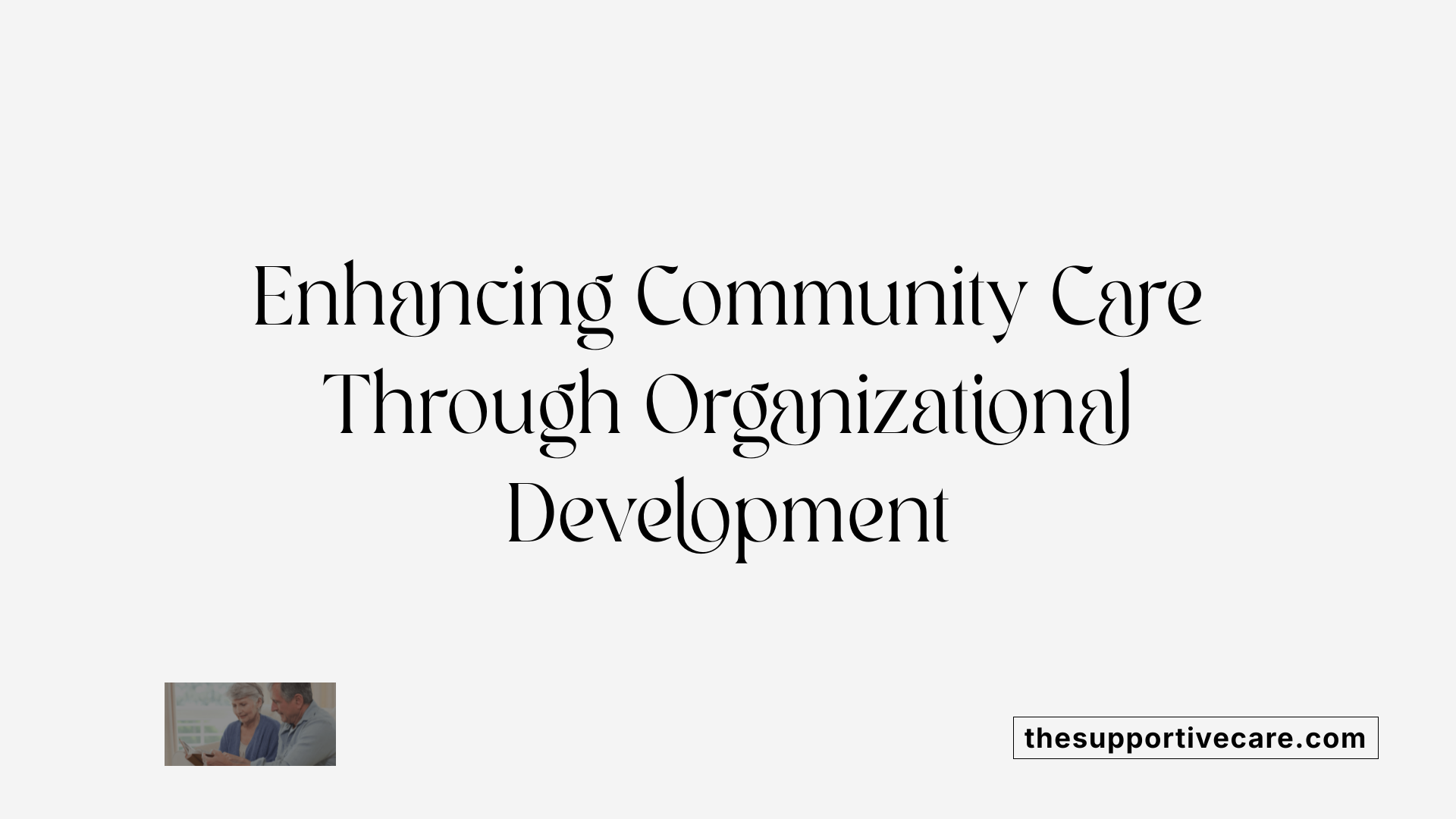
Program assessment and evaluation
Effective organizational capacity building begins with thorough program assessment and evaluation. This process involves examining current service offerings, referral mechanisms, and client outcomes to identify gaps and areas for improvement. Organizations that regularly evaluate their programs ensure that their services align with community needs and support seamless integration within a broader network of care. By tracking referral sources, appointment delays, and feedback from specialists, agencies can refine their processes to increase efficiency and better serve clients.
Cross-training staff to broaden skills
Cross-training staff across disciplines enhances an organization's ability to contribute effectively within interconnected networks. When staff possess a broader range of skills and knowledge about various service areas—such as substance use treatment, mental health care, and social support services—they can facilitate more holistic client engagement and referrals. This multidisciplinary approach fosters collaborative relationships with partner agencies and promotes comprehensive care that addresses multiple facets of clients' needs.
Enhancement of network functionality
Building organizational capacity also requires strengthening the functionality of the entire service network. This includes implementing integrated communication systems, such as behavioral health software, which streamline information exchange between agencies and reduce administrative burdens. Additionally, maintaining an up-to-date resource inventory enables timely and efficient referrals. Establishing mutual provider credibility and trust among agencies further bolsters network cohesion, enabling coordinated efforts to prevent clients from "falling through the cracks." These enhancements ultimately improve client outcomes by ensuring continuity and comprehensiveness in behavioral health services.
Resource Mapping and Community Resource Inventories

Why Are Updated Resource Databases Important?
Maintaining an updated resource database is essential for behavioral health referral programs. Regular updates allow agencies to accurately track available services, reducing the risk of clients being referred to sites that lack capacity or the specific interventions needed. These databases provide reliable information on treatment options, appointment availability, and specialist contacts, which makes the referral process smoother and more effective.
What Types of Services Should Be Included?
Community resource inventories should go beyond just treatment centers and include a variety of vocational programs and support services. Incorporating vocational training, employment assistance, and social support services ensures that referrals can address the full spectrum of client needs. This holistic approach helps meet underlying social determinants that influence recovery, such as stable employment and skills development.
How Do These Inventories Improve Referral Efficiency?
Real-time access to a comprehensive resource inventory enables providers to quickly identify the best fit for their client’s needs. This reduces delays caused by unnecessary phone calls or data searches and minimizes appointment cancellations or missed opportunities for treatment. Additionally, up-to-date inventories support better coordination among providers by promoting transparency about service capacities and availability.
By linking accurate community resource information with behavioral health referral efforts, organizations can achieve more timely, tailored, and client-centered care. This not only streamlines the referral process but also helps prevent gaps in services that often lead to clients "falling through the cracks."
Incorporating Cultural Competence in Referral Processes
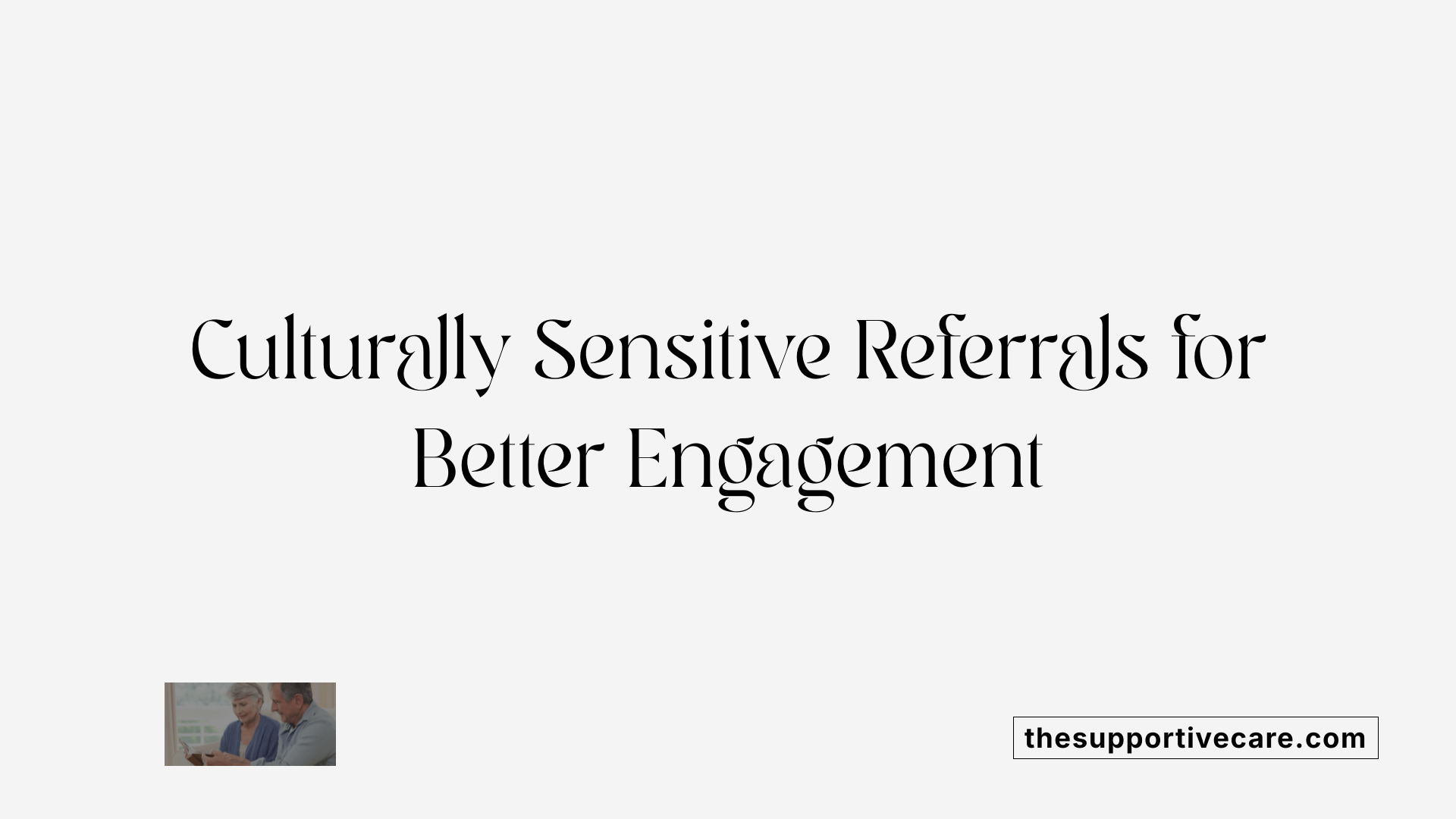
Understanding clients’ cultural backgrounds
Cultural competence in substance abuse treatment referrals involves recognizing the diverse cultural, ethnic, and community contexts of clients. Agencies must appreciate how clients' beliefs, traditions, and values influence their health behaviors and treatment preferences. This understanding ensures that referral recommendations align with each client’s unique needs and cultural realities.
Respect for diversity and family contexts
Effective referrals are grounded in respect for diversity, including racial, ethnic, linguistic, and familial backgrounds. Family dynamics often play a critical role in recovery and must be respected when designing care pathways. Providers who acknowledge these factors foster trust and create an environment where clients feel understood and supported.
Impact on client engagement and treatment success
When cultural competence is integrated into referral processes, clients are more likely to engage with services and adhere to treatment plans. Respect for cultural identity reduces stigma, enhances comfort in the care setting, and improves communication between clients and providers. Ultimately, this leads to stronger therapeutic alliances, better retention, and improved treatment outcomes.
In summary, incorporating cultural competence into referral networks promotes client-centered care that honors clients’ backgrounds, encourages sustained engagement, and supports successful recovery trajectories.
Multidisciplinary Teams for Comprehensive Care Coordination
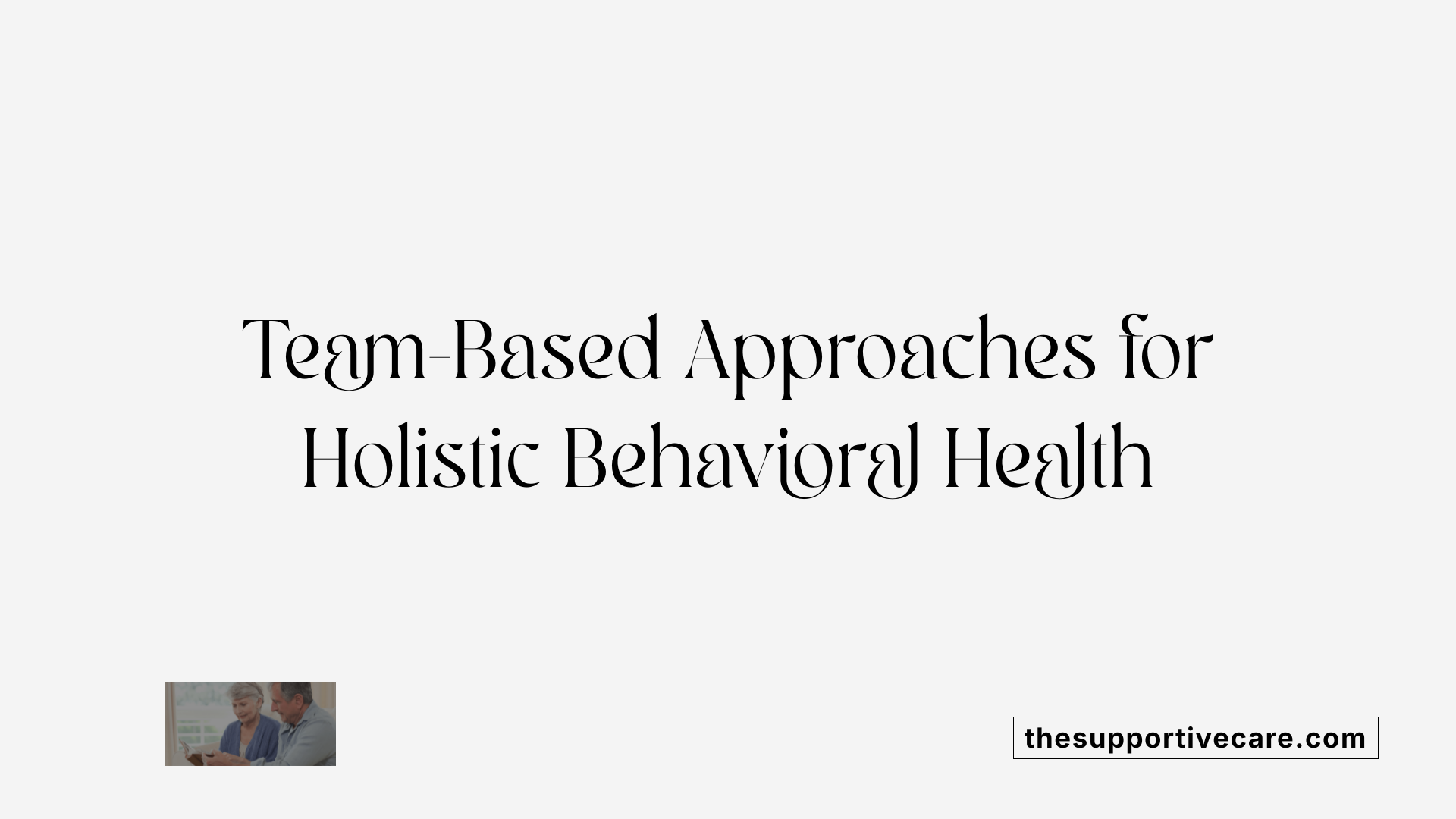
Collaborative Work Among Diverse Professionals
Multidisciplinary teams bring together professionals from various service areas—including substance abuse treatment, mental health, social work, and primary care—to work collaboratively. This diverse collaboration ensures that clients receive well-rounded support addressing multiple facets of their condition and social context.
Improving Treatment Comprehensiveness
By pooling expertise across specialties, multidisciplinary teams help create more comprehensive treatment plans. These teams can identify unaddressed needs and coordinate referrals to appropriate services, thereby reducing the risk of patients 'falling through the cracks.' Their holistic view supports trauma-informed care, psychosocial interventions, and medication-assisted treatment when needed.
Enhancing Communication During Referrals
Effective communication is vital during referrals. Multidisciplinary teams facilitate shared assessments and enhance information exchange between agencies, providers, and community resources. This interconnected approach reduces duplication, minimizes delays, and improves continuity of care by designating primary contacts who oversee coordinated treatment across sectors. Integrated behavioral health software and organized communication systems further support this process, promoting mutual trust and credibility among providers.
Leveraging Technology: Referral Software and Integrated Systems

Tracking patient outcomes and referral metrics
Referral software systems enable behavioral health providers to systematically track various metrics such as referral sources, appointment scheduling times, delays, missed appointments, and feedback from specialists. This comprehensive data collection supports an ongoing assessment of how well referral programs meet both organizational goals and patient needs, ensuring that care pathways remain efficient and effective.
Reducing wait times and administrative burdens
Integrated communication systems, including specialized behavioral health software, streamline the referral process by facilitating seamless information exchange between primary care physicians and specialists. This integration helps reduce wait times for appointments and minimizes administrative tasks such as redundant paperwork or duplicate testing, ultimately improving the patient experience and promoting timely access to care.
Facilitating real-time data sharing between providers
One of the major challenges in behavioral health referrals is the lack of real-time awareness about treatment capacity. Technology solutions address this by enabling providers to share up-to-date information on availability and patient eligibility criteria, overcoming traditional barriers linked to confidentiality restrictions and fragmented communication. Real-time data sharing fosters trust and mutual credibility among agencies, supporting holistic, integrated service networks that better serve clients’ needs.
Integrating these technological advances into community referral networks enhances value-based care models. This integration supports evidence-based practices by tracking patient clinical outcomes and ensuring continuous improvement in treatment quality and access across the spectrum of behavioral health services.
Streamlining Referral Structures to Enhance Patient Experience

Convenient Appointment Scheduling
Streamlined referral processes are essential for enabling patients to schedule appointments more conveniently. By organizing and integrating communication systems, such as through the use of integrated behavioral health software, primary care physicians and specialists can coordinate closely. This coordination reduces the administrative burden and allows patients easier access to the services they need, minimizing wait times.
Avoiding Duplicated Tests and Delays
Efficient referral structures help prevent unnecessary duplication of diagnostic tests, which not only reduces healthcare costs but also speeds up treatment initiation. When agencies share information seamlessly through interconnected networks, patient histories and treatment needs are clearly communicated. This continuity reduces delays typically caused by fragmented care and ensures timely interventions.
Reducing Provider Miscommunication
Miscommunication among providers is a common barrier in behavioral health referrals. Streamlined referral workflows, supported by shared assessments and electronic referral software, cultivate mutual credibility and trust among providers. Clear channels for information dissemination enable all parties to stay updated on patient progress, resulting in cohesive care plans and better client outcomes.
Challenges in Referral: Eligibility and Capacity Transparency

Lack of Universal Patient Eligibility Criteria
One of the foremost challenges in behavioral health referrals for substance use disorder treatment is the absence of standardized eligibility criteria across treatment facilities. Without universally applied guidelines, referral providers often face uncertainty about whether a patient qualifies for certain treatment programs. This complexity can delay access to care or lead to inappropriate referrals that further frustrate patients and providers alike.
Treatment Facilities’ Capacity Reporting Deficiencies
Many treatment centers lack real-time digital systems to report their current capacity status. As a result, referring agencies are left guessing about availability, which leads to misjudgments and underutilization of treatment options. The inability to access timely capacity data hinders efficient placement of patients, contributing to fragmented and delayed care.
Provider Knowledge Gaps About Treatment Options
Another factor complicating the referral process is insufficient provider education regarding the full spectrum of available treatment modalities, including evidence-based practices such as medication-assisted treatments and psychosocial interventions. Limited knowledge on the part of referral sources restricts their ability to match clients appropriately with treatment services that suit their needs, often resulting in underutilization of effective therapies.
Addressing these barriers requires implementing clear eligibility standards, enhancing capacity transparency through integrated reporting systems, and bolstering provider training. These steps can streamline referrals, improve access, and ensure individuals receive the most appropriate and timely care.
Education and Training to Improve Referral Appropriateness
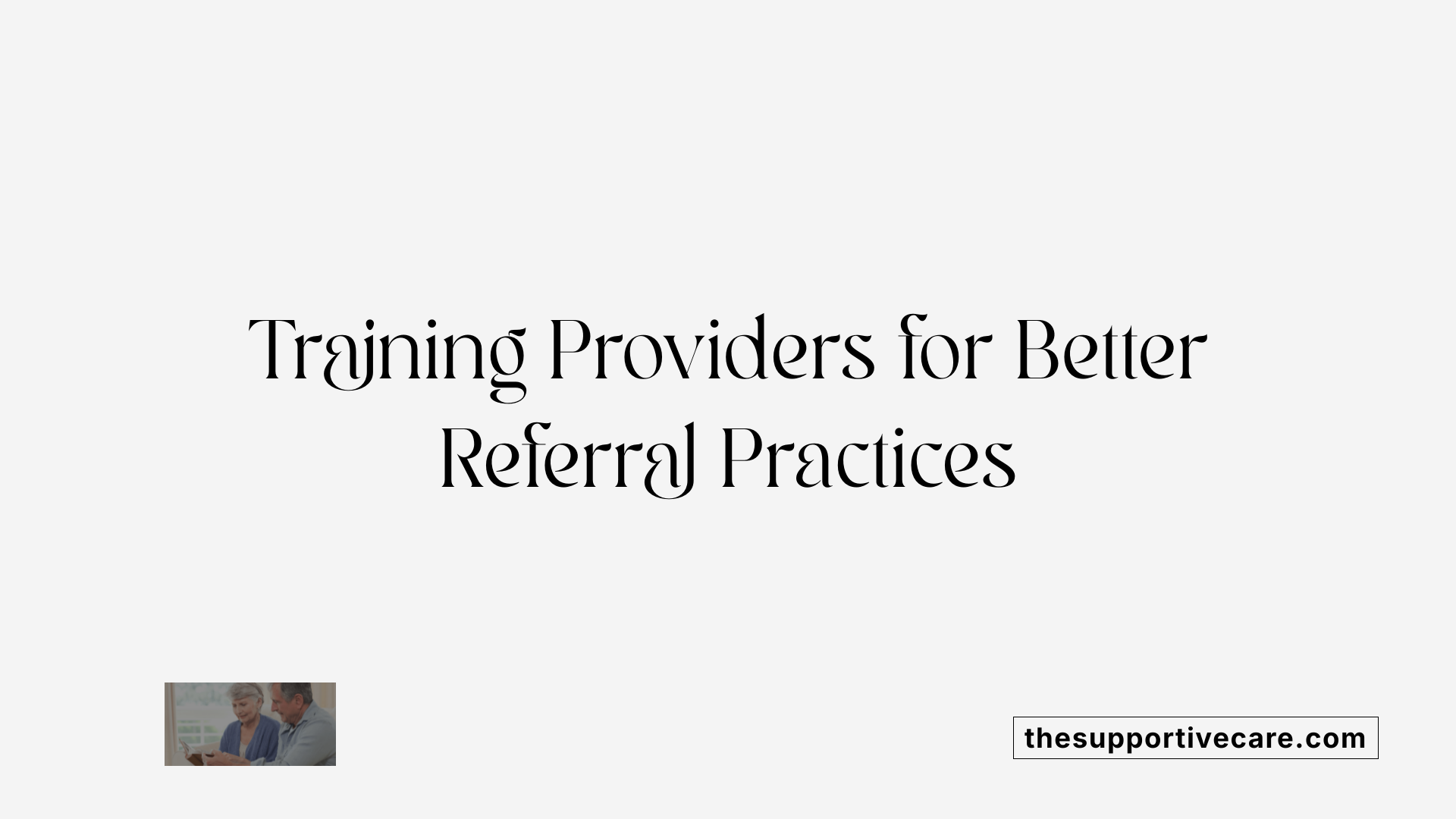
Why is Provider Education on Evidence-Based Practices Important?
Provider education is crucial in ensuring that referrals for substance abuse treatment are appropriate and effective. Many providers currently have limited knowledge of the full spectrum of treatment options, including medication-assisted treatments like buprenorphine and naltrexone, psychosocial interventions, and trauma-informed care. Enhancing education about these evidence-based practices enables providers to make informed referrals, reducing inappropriate placements and improving patient outcomes.
How Does Cross-Sector Training Enhance Treatment Modalities?
Cross-sector training brings together professionals from various fields such as behavioral health, primary care, social services, and community organizations. This multidisciplinary approach helps providers understand the interconnectedness of client needs and the variety of treatment modalities available. Training staff across agencies promotes a shared language, mutual credibility, and trust, which are vital for seamless referral processes and integrated care.
In What Ways Does Education Improve Referral Quality and Patient Outcomes?
Enhanced provider education leads to better identification of patient eligibility, more accurate referrals, and stronger follow-up procedures. When providers understand treatment capacity, eligibility criteria, and evidence-based treatments, they can more effectively match patients to appropriate services. Furthermore, educated providers contribute to building strong referral networks, utilizing technologies like integrated behavioral health software to track referrals and outcomes. This comprehensive approach reduces delays, miscommunication, and treatment drop-offs, ultimately improving patients’ access to quality care and long-term recovery success.
Innovative Community-Based Strategies for Early Intervention

Outreach and Engagement Meeting Clients Where They Are
Effective behavioral health systems prioritize active outreach and engagement by meeting clients in their own communities. Community-based organizations play a vital role by offering preventive and early intervention services within trusted, familiar environments. These services are often delivered in multiple languages and tailored to specific community contexts, improving access and reducing reliance on hospital care.
Use of Telehealth and Mobile Clinics
Telehealth has become a critical modality for behavioral health services, especially with expanded accessibility during the COVID-19 pandemic. It offers flexible, remote care options that bridge geographic and logistical barriers, although some challenges persist. Complementing this, mobile health clinics provide accessible, cost-effective screening, medication management, and referral services. These clinics are particularly impactful in rural or underserved areas, bringing care directly to populations with limited transportation or availability for in-person visits.
Lower-Threshold Treatment Programs and Harm Reduction
Lower-threshold programs like syringe exchanges and overdose prevention initiatives improve engagement among high-risk populations by minimizing barriers to access. Regulatory easing during COVID-19 has facilitated more flexible delivery of these harm reduction services. Furthermore, decriminalizing behavioral health conditions and diverting affected individuals from police involvement toward community crisis response models enhance outcomes and reduce recidivism. Mobile crisis teams and peer supports deliver timely, compassionate alternatives to traditional law enforcement responses, proving cost-effective compared to hospitalization.
Together, these innovative community-based strategies form a holistic approach that enhances early identification, engagement, and sustained treatment for individuals with behavioral health needs.
Addressing Social Determinants of Health in Behavioral Health Care

Integrating Housing, Employment, and Education Support
Successful behavioral health care extends beyond clinical treatment by incorporating essential social determinants such as housing stability, employment opportunities, and education access. Integration of these supports is crucial as they directly influence recovery trajectories and help sustain long-term wellness. Behavioral health services that collaborate with housing programs, job training, and educational resources offer a comprehensive network of support, addressing barriers that often hinder patient progress.
Impact on Recovery and Reducing Disparities
Addressing social determinants improves recovery outcomes by mitigating factors that contribute to relapse or disengagement from treatment. Stable housing reduces stress and provides a safe environment for healing, while employment enhances self-worth and economic independence. Education empowers individuals with skills and knowledge, promoting resilience. Moreover, tailored approaches reduce health disparities by acknowledging and respecting varied community and cultural contexts, thus fostering equitable care for diverse populations.
Policy and Workforce Diversity Considerations
Policies promoting workforce diversity and provider training in structural competency are essential for quality behavioral health care. Diverse healthcare teams are better equipped to understand and address the unique challenges faced by different populations. Integrating clinical and social data, supported by policy frameworks, enables providers to design patient-centered strategies that consider both medical and social needs. This holistic approach not only improves outcomes but also advances health equity, ensuring that all individuals receive culturally competent and comprehensive care.
Performance Measurement and Quality Reporting in Referral Systems

Using Measures Like Initiation and Engagement of Treatment (IET)
A crucial tool for assessing referral systems in behavioral health care is the Initiation and Engagement of Alcohol and Other Drug Dependence Treatment (IET) measure. Endorsed by the National Committee for Quality Assurance (NCQA), the IET helps track how effectively healthcare plans start and sustain patients in treatment for substance use disorders. It provides objective data on treatment initiation and engagement rates, which are vital indicators of referral system performance.
Applying Data Analytics for Continuous Improvement
Beyond simple tracking, data analytics plays a pivotal role in refining referral processes. Health plans and agencies use analytics to evaluate performance trends, identify gaps in service delivery, and address barriers to care. This ongoing analysis supports targeted improvements like enhancing coordination, optimizing appointment scheduling, and reducing missed referrals. Tracking referral sources, appointment delays, and specialist feedback further bolsters this continuous improvement.
Supporting Value-Based Care and Health Plan Structures
Effective referral measurement also underpins value-based care models, which reward positive clinical outcomes. By integrating referral data, health plans can design benefit structures, provider networks, and reimbursement strategies that facilitate access to evidence-based treatments. Integrated care approaches and the co-location of services have been associated with higher initiation and engagement rates, illustrating how performance metrics guide system enhancements and health plan design to better meet patient needs.
Toward Seamless Referral Pathways in Behavioral Health
Creating seamless referral processes for behavioral health in treatment facilities demands an integrated approach encompassing comprehensive service offerings, strong interagency collaboration, capacity building, and the adoption of digital technologies. Addressing barriers such as confidentiality, competition, and uneven provider training is essential to reduce fragmentation and improve care continuity. Community-based strategies and attentiveness to social determinants further enhance engagement and treatment success. As behavioral health needs grow, evolving referral networks into interoperable, patient-centered systems supports better clinical outcomes and fosters long-term recovery for diverse populations.
References
- Chapter 5—Effective Referrals and Collaborations - NCBI - NIH
- How to Manage Behavioral Health Referrals
- Evidence-Based Practices Resource Center
- Gaps in the Substance Use Disorder Treatment Referral Process
- Transforming Mental Health And Addiction Services
- Best Practices and Barriers to Engaging People with ...
- BEST PRACTICES GUIDELINES
- Finding Help for Co-Occurring Substance Use and Mental ...
- Substance Use Disorder (SUD): Symptoms & Treatment

































